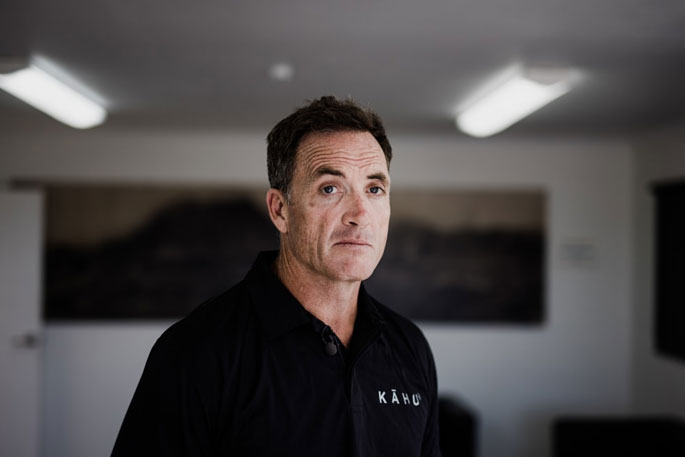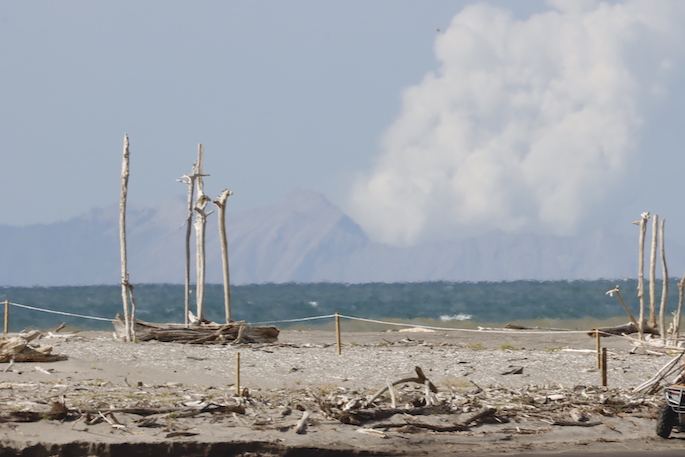
Pilot Mark Law took part in rescue efforts after the Whakaari / White Island eruption in December 2019. Photo: RNZ / Dom Thomas.
Dispatch orders from the New Zealand’s Air Ambulance Service diverted rescue and paramedic helicopters to Whakatāne, as landing on the island was deemed too dangerous post eruption, says a statement about the awards.
Law was the first person to arrive on the island after it erupted.
He says it's difficult to reconcile his happy memories of the island with the traumatic scene he encountered upon landing.
"Seeing so many people in one area who were in so much distress and people that had passed away, in an area that brought so much joy to so many people during all the tours and visits to the island," he said. "That's probably the hardest thing, I think, that probably struck us all."
He had been driving along the coast of the mainland when he saw a dark plume emanating from the volcano. He said he did not stop to think about whether he should go.
Within 50 minutes, Law had landed his helicopter on the island's landing pad, put on a gas mask, and begun his search, shin-deep in ash.
Law had found 20 people at the volcano's crater, eight of whom had already died, by the time Tom Storey and Jason Hill landed in another Kāhu helicopter.
With acidic air a present issue for the helicopter engines, the pilots left their engines on and rotors turning once landed to improve their chances of taking off again.
The casualties were covered in thick ash, had extensive burns and were in various stages of consciousness.
Ash fell on the men as they moved about and the acidic air made breathing difficult.
Time was of the essence, which became clearer when a young woman died in Storey's arms while he was carrying her to the helicopter.
Soon enough, Volcanic Air director and pilot Tim Barrow and pilots Graeme Hopcroft, Callum Mill and Sam Jones arrived from Rotorua in two helicopters to help load people.
Three helicopters flew to Whākatane hospital with 12 injured people on board within just 40 minutes.
Still on the island, Storey, Mill and Jones did a final sweep to ensure there were no remaining survivors.
They carefully grouped bodies close together, placing found phones with the deceased person to help with identification.
Whakaari/White Island on the day of the fatal eruption.
The efforts of the commercial helicopter pilots and crew resulted in 20 casualties being found on the crater floor, with 12 injured being removed by the commercial helicopters over the course of 40 minutes, and eight deceased repositioned for later recovery. “
Of the 12 people helicoptered out, 10 died.
Law says it has been a tough few years since the eruption.
"It destroyed our business, that's for sure," he says.
"Put a massive amount of strain on me, and then Covid and all the rest of the story."
In November 2020, just before the first anniversary of the disaster, WorkSafe announced it was laying charges against 13 organisations and individuals.
Those charged are: the island's owner Whakaari Management Limited and its directors Andrew, James and Peter Buttle; GNS Science; the National Emergency Management Agency; White Island Tours Limited; Volcanic Air Safaris Limited; Aerius Limited; Kahu NZ Limited; Inflite Charters Limited; I D Tours New Zealand Limited; and Tauranga Tourism Services Limited.
It specifies the charges do not relate to events on the day of the eruption, or the rescue efforts.
All parties have denied the charges they faced.
"Being labelled criminals is never the most helpful thing in the world," Law says.
While the bravery award did not take the sting out of the WorkSafe prosecution, it did remind him that New Zealanders valued helping each other.
"There's still some really good people who treasure effort," he says.
"[If] that's someone's life, just go."
-Additional reporting by RNZ.
Credit: sunlive.co.nz


